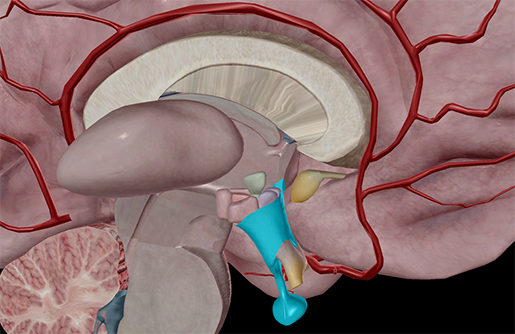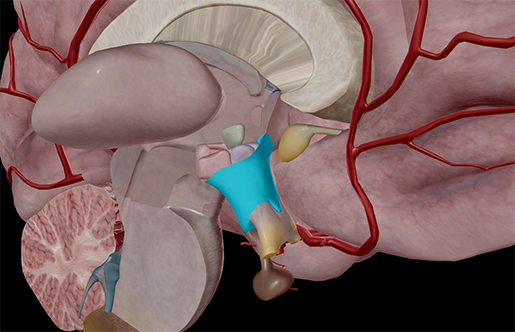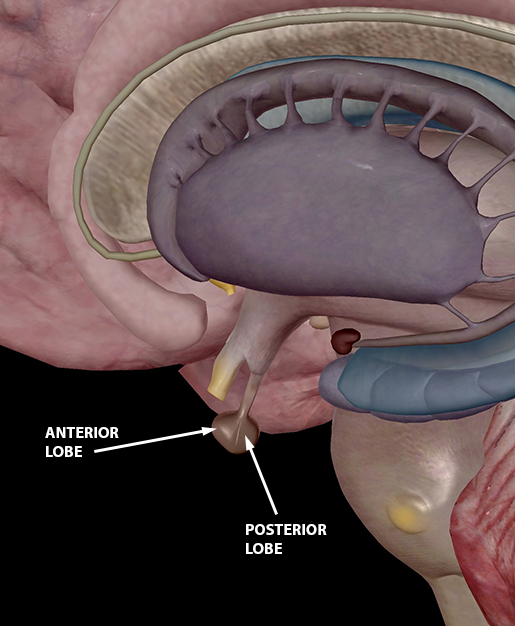The Endocrine System: Hypothalamus and Pituitary
Posted on 1/2/15 by Courtney Smith
Are you hot right now? Cold? Maybe you're like Goldilocks and are just right. What about your height? Are you tall? Average? Short? Maybe your metabolism is lightning fast and you're always hungry, or maybe it's a bit slow and you stay full longer. All of these—regardless of which one you identify with—are regulated by the endocrine system.
What is the endocrine system? It's a network of glands throughout the body that regulate certain body functions, including body temperature, metabolism, growth, and sexual development.
Want to learn more about glands and hormones? Check out our free Endocrine System eBook!
Though there are many glands, today we’ll focus on just two: the hypothalamus and the pituitary gland.

Image from Visible Body Suite.
I'm going to be throwing a lot of information at you, dear reader, so brace yourself!
Hormone Reaction Regulation
It’s no secret your brain is one busy place—neurons move at incredible speeds, synapses are constantly firing, blood is pumping, and glands are producing hormones. These glands, specifically the hypothalamus and pituitary, are working all the time to keep your body running at optimal performance. Every hormone the endocrine system releases follows a basic set-up: a signal is received, hormones are secreted, and the target cell undergoes changes to its basic functions.
Hypothalamus
The almond-sized hypothalamus is located below the thalamus and sits just above the brainstem. All vertebrate brains have a hypothalamus. Its primary function is to maintain homeostasis (stability of the internal environment) in the body.

Image from Visible Body Suite.
The hypothalamus links the nervous and endocrine systems by way of the pituitary gland. Its function is to secrete releasing hormones and inhibiting hormones that stimulate or inhibit (like their names imply) production of hormones in the anterior pituitary. Specialized neuron clusters called neurosecretory cells in the hypothalamus produce the hormones Antidiuretic Hormone (ADH) and Oxytocin (OXT), and transport them to the pituitary, where they're stored for later release.
Think of the hypothalamus as the pituitary's older sibling—it not only controls the actions of the pituitary but it secretes at least nine hormones to the pituitary's seven.
Pituitary Gland
Attached to the hypothalamus, the pituitary gland is a pea-sized, reddish-gray body that stores hormones from the hypothalamus and releases them into the bloodstream. The pituitary consists of an anterior lobe and a posterior lobe, each of which have distinct functions.
 Image from Visible Body Suite.
Image from Visible Body Suite.
Pituitary: Anterior Lobe (Adenohypophysis)
The anterior lobe (or adenophyophosis) secretes hormones that regulate a wide variety of bodily functions. The anterior lobe is made up of three parts: the pars tuberalis, pars distalis, and pars intermedialis.
%20(1).jpg?width=515&height=386&name=screenshot%20(3)%20(1).jpg)
Image of hypothalamus and pituitary microanatomy model in Visible Body Suite.
There are five anterior pituitary cells that secrete seven hormones:
|
Somatotrophs |
Secrete human growth hormone (hGH), aka somatotropin, which stimulates tissues to secrete hormones that stimulate body growth and regulate metabolism. |
|
Gonadotrophs |
Secrete follicle-stimulating hormone (FSH) and luteinizing hormone (LH), which both act on the gonads. They stimulate the secretion of estrogen and progesterone, maturation of egg cells in the ovaries, and stimulate sperm production and secretion of testosterone in the testes. |
|
Lactotrophs |
Secrete prolactin (PRL), which initiates milk production in the mammary glands. |
|
Corticotrophs |
Secrete adrenocorticotropic hormone (ACTH), which stimulates the adrenal cortex to secrete glucocorticoids (like cortisol). Also secretes melanocyte-stimulating hormone (MSH). |
|
Thyrotrophs |
Secrete thyroid-stimulating hormone (TSH), which controls secretions of the thyroid gland. |
This table represents the types of hormones secreted by the cells of the anterior pituitary.
|
Name |
Target Area |
Function |
|
Human-growth hormone (hGH) |
Tissues |
Stimulates tissue growth in the liver, muscles, bones, as well as protein synthesis, tissue repair, and elevation of blood glucose levels. |
|
Thyroid-stimulating hormone (TSH) |
Thyroid gland |
Stimulates thyroid gland to secrete thyroid hormones. |
|
Follicle-stimulating hormone (FSH) |
Ovaries and testes (gonads) |
Stimulates development of oocytes (immature egg cells) and secretion of estrogen in females; stimulates sperm production in the testes in males. |
|
Luteinizing hormone (LH) |
Ovaries and testes (gonads) |
Stimulates secretion of estrogen and progesterone, including during ovulation, in females; stimulates testes to produce testosterone in males. |
|
Prolactin (PRL) |
Mammary glands |
Stimulates milk production. |
|
Adrenocorticotropic hormone (ACTH) |
Adrenal cortex |
Stimulates secretion of glucocorticoids (cortisol) by the adrenal cortex during the body’s response to stress. |
|
Melanocyte-stimulating hormone (MSH) |
Brain |
When in excess, can cause darkening of the skin; may influence brain activity (its exact role unknown—there is very little MSH in humans). |
Pituitary: Posterior Lobe (Neurohypophysis)
While the anterior lobe shoulders most of the work in producing hormones, the posterior lobe stores and releases only two: oxytocin and antidiuretic hormone (ADH), or vasopressin.
.jpg?width=515&height=386&name=screenshot%20(2).jpg)
Image of hypothalamus and pituitary microanatomy model in Visible Body Suite.
|
Name |
Trigger |
Function |
|
Oxytocin (OT), aka the "love" drug |
Secretes in response to uterine distention and stimulation of the nipples. |
Stimulates smooth muscle contractions of the uterus during childbirth, as well as milk ejection in the mammary glands. |
|
Antidiuretic hormone (ADH), or vasopressin |
Secretes in response to dehydration, blood loss, pain, stress; inhibitors of ADH secretion include high blood volume and alcohol. |
Decreases urine volume to conserve water, decreases water loss through sweating, raises blood pressure by constricting arterioles. |
Pituitary Disorders
Even though it's very small, the pituitary gland isn't free from ailment—nothing is completely foolproof, after all.
Most disorders of the pituitary glands are tumors, which are common in adults. These growths are not considered brain tumors, nor are they always malignant. In fact, they're almost always benign in nature! There are two types of pituitary tumors—secretory and non-secretory. A secretory tumor produces too much of a hormone, while a non-secretory tumor does not. Regardless, if the tumor is big enough, it can hinder normal pituitary function. These tumors can be removed, or monitored and controlled with medication.
Problems caused by tumors fall into certain categories:
-
Hyposecretion: Too little of a hormone is produced, interfering in normal function.
-
Hypersecretion: Too much of a hormone is produced, interfering in normal function.
-
Mass effects: The tumor presses on the pituitary or other areas of the brain, causing pain, vision issues, or other problems.
While the pituitary and hypothalamus can run into the above issues, on the whole they work a balancing act on your body. So the next time you're feeling juuuust right, you can thank the pituitary, hypothalamus, and all the other organs of the endocrine system.
Be sure to subscribe to the Visible Body Blog for more anatomy awesomeness!
Are you an instructor? We have award-winning 3D products and resources for your anatomy and physiology course! Learn more here.





